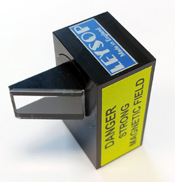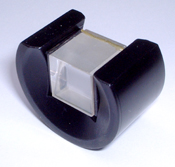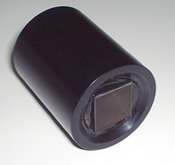Faraday Optical Rotators and Isolators
For prevention of back-reflections

The Faraday effect causes a rotation of the plane of light polarization when a light beam passes through a material in the presence of an axial magnetic field. The effect is similar to that produced when a light ray passes through an optically active material such as quartz. However, the effect is different to optical activity in that the sense of the rotation angle is not dependent on the direction of propagation through the medium.
Light passing one way through the medium will be seen by an observer as having its polarization axis rotated through a clockwise angle for example. If the light is retro-reflected back through the same medium however, the same observer would again see the light polarization axis rotate through an additional, equal clockwise angle (whereas in an optically active medium the light would have undergone first a clockwise then an equal anti-clockwise rotation returning it to its original state). A device which exhibits this behaviour is called a faraday rotator.
The basic design of a practical device is to use a rod of optical material placed in the axial magnetic field produced by permanent magnets, usually face magnetized toroids. Some optical glasses (e.g. SF57 and special grades of glass selected for their Verdet constant) may be used, but we only use the highest quality single crystal TGG (terbium gallium garnet). This offers the highest Verdet constant for the visible to near infra red region and provides high power handling with low optical distortion.
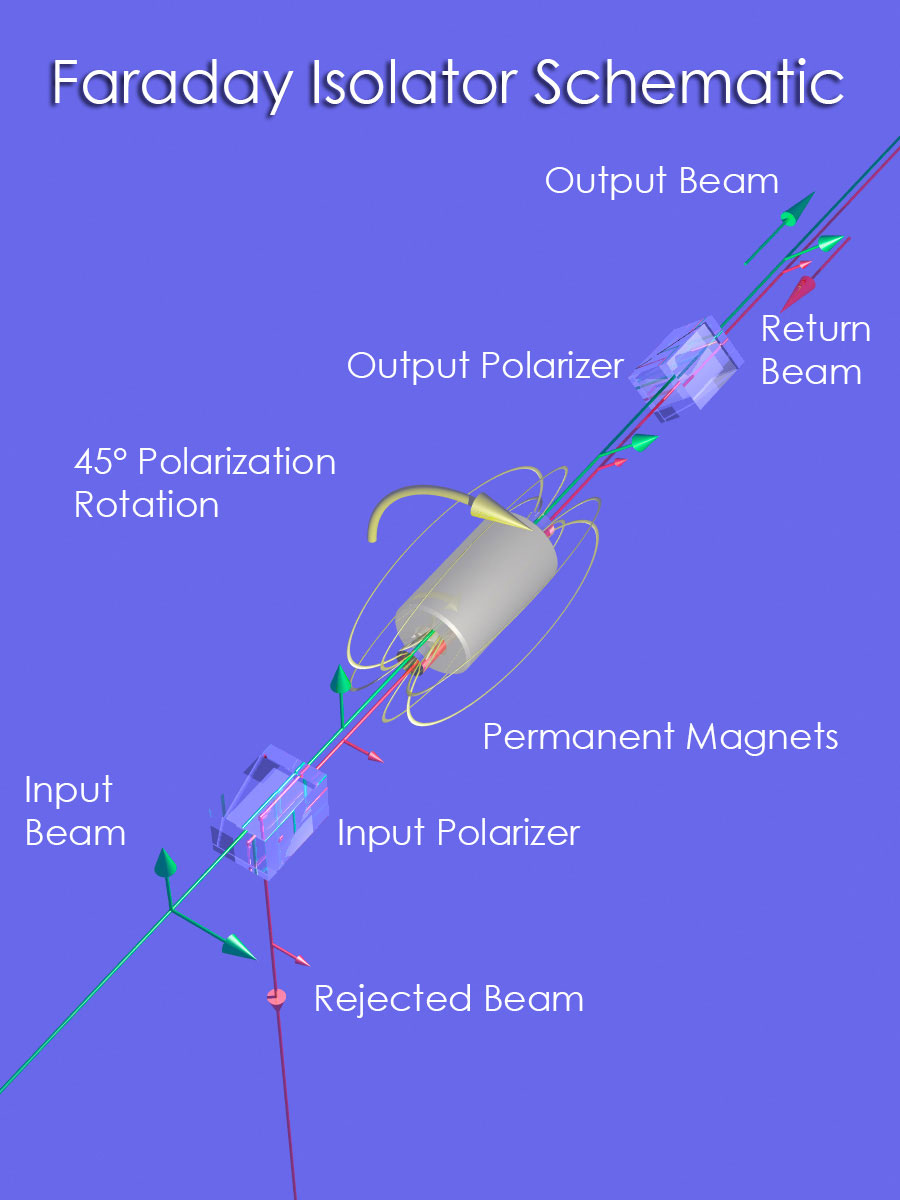
To make a Faraday isolator, it is necessary to add a pair of polarizers to the rotator and to set the rotation angle to be 45°. Rotation is additive for reflectors passing back through the isolator giving 90° difference between the input and reflected polarisation states at the input to the isolator. The input polariser will therefore reject back reflections. An output polariser is necessary to clean up the polarisation state for transmission back through the isolator (see diagram) and thus to ensure good isolation even if the light is de-polarized before returning through the device.
The Faraday effect is weak, even in TGG and so a strong magnetic field is required. It is also wavelength sensitive as the verdet constant (which provides a sort of figure of merit) is strongly wavelength dependent. At increasing wavelengths, it is required to use especially strong magnetic fields in order to achieve a 45° rotation angle. There are therefore two basic designs of isolators in our range. For the shorter wavelengths we provide our FOI 5/57 design. This uses a simple arrangement of the permanent magnets and as a result, is slightly smaller than the longer wavelength model (FOI 5/711) where a special arrangement is used to increase the magnetic field strength to the very high levels required to obtain 45° rotation at ~1µm. The 5/57 isolators are wavelength tunable by a screw thread adjustment which adjusts the degree of insertion of the TGG rod into the magnet assembly. This operation requires removal of the input polarizer to allow access to the rod (the polarizer is simple to re-fit in position).
Because the FOI 5/711 unit uses an opposing magnet arrangement, it is adjusted instead by increasing or reducing the separation of the opposed magnets. This changes the field strength in the central region where the TGG rod is fixed. The whole housing is adjusted for this process (one section screws into the other) and we again suggest that in most cases the removal of the polarizer is sensible. In general, the FOI 5/57 model may be tuned over a wavelength range of about 100-150nm, whilst the FOI 5/711 model has a more restricted tuning range of about 5% either side of the factory set wavelength. This arrangement may seem cumbersome compared to the method often used by other manufacturers in which the device is tuned for different wavelengths simply by rotating the angle of the output polarizer compared to the input. However, at all relative angles other than 45° it is easy to see that the resulting misalignment of the output polarizer to the plane of input polarization after the TGG rod will cause an additional insertion loss in the forward transmission which can be quite considerable. Our method of obtaining true tuning without increasing insertion loss is thus more effective at increasing the relative contrast between forward and backward waves in the system.
This brings us to the subject of isolation. It is very easy to specify that a device will provide >-40dB isolation of light propagating in the backward direction. However, without specifying conditions this is meaningless. A practical specification should tell the user what he or she can expect to achieve under 'Real World' conditions. Therefore for our 5mm aperture devices we quote a minimum value of >-30dB isolation which will be applicable for beams of up to ~3.5mm diameter and over a range of temperatures typical of those encountered in a normal un-controlled laboratory environment. We do not like to engage in'specmanship' so prefer to quote this more realistic figure. Of course with careful setup and temperature control, a figure of >-40dB is perfectly possible to achieve.
Input and output polarisers can be supplied and are mounted onto the isolator forming an integral system. We supply as standard our own excellent Glan-Taylor type calcite polarizers when a complete isolator is requested, although we are happy to fit alternative types on request or equally to provide a rotator unit only if required.
Product Specifications

|
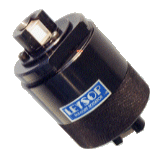
|
|
| Model | FOI-5/57 | FOI-5/711 |
| Aperture (mm) | 5 | 5 |
| Wavelength (nm) | 500 - 900 | 900 - 1100 |
| Isolation (db) | > 30 | > 30 |
| Insertion Loss (dB) | < 0.5 | < 0.5 |
| Tunable |
Three Ranges 500 - 750, 750 - 850 and 800-900 |
±5° rotation about fixed wavelength |
| Dimensions (mm) | ||
| Excluding Polarisers | 60 dia x 58 long | 75 dia x 75 long |
| With Polarisers | 60 dia x 100 long | 75 dia x 120 long |
In addition to the above 5mm aperture units, we are also able to supply 8mm aperture alternatives (e.g. FOI-8/57 and FOI-8/711) on request. Please be aware though that the cost of the larger TGG rods is significantly higher for this small increase in diameter and that larger and heavier magnets are also required. The cost of these rotators/isolators are thus somewhat higher than the smaller aperture models.
Broad-Band Rotators/Isolators for Ti:Sapphire
Our tunable isolators as described above are ideal for fixed wavelength operation or where only occasional adjustment is required between experiments when the source wavelength has been changed. These adjustments however are relatively time consuming to make and are not convenient where a broadband or rapidly tunable source such as a dye laser or one of the new classes of vibronic mode lasers such as Ti:Sapphire are used. There is not much point in having a laser source which can be tuned to a different wavelength within seconds if the Faraday isolator in the system requires removing from the bench/equipment and set up off line for optimum performance. This is where our new broad-band units come into their own.By inserting a passive optical element (quartz rotation plate) into the device in addition to the TGG rod, the combination of the two components is an isolator in which the the output polarisation is now at the more convenient angle of 90° with respect to the input. More importantly, it can be shown that the isolation of the unit is now maintained over a wide bandwidth instead of at just one wavelength. Our broadband isolator is designed for use over the range of wavelengths covered typically by the very important Ti:Sapphire laser source, that is 700nm to 900nm. Over this range, the isolation should remain greater than about 27dB without any retuning being required. There is a small penalty to pay in that the transmission over the band is not uniform due to the varying degree to which the combined rotation of the Faraday rod and the quartz rotator matches the outgoing polarisation axis to the preferred axis of the output polariser.
The price for this broadband isolator (or rotator if you prefer) is very similar to that of the wavelength tunable units. If you wish to discuss how this unit could improve your optical system or to look at alternative wavelength options, please do not hesitate to contact us.
Ultra-Wide Tuning Range Faraday Isolator
In response to customer demands for isolators with increasingly broad tuning ranges (it was much easier for us manufacturers before all these new sources became available!) we have introduced a new design of isolator.
This is based on our FOI5/57 design but uses a slightly longer than normal TGG rod and greater strength magnet assembly to increase the maximum wavelength of operation and more importantly a new more convenient wavelength tuning assembly.
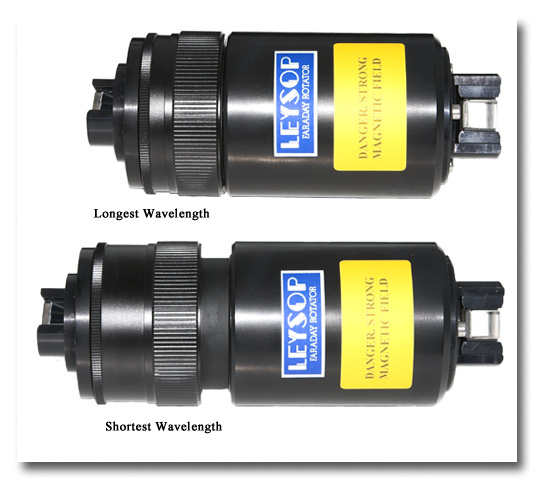 The photograph above shows the device at the two extremes of the tuning range. It also shows clearly the helicoidal tuning mechanism which produces pure translation of the TGG rod into the magnet assembly, without rotation of either the rod or alteration of the relative orientation of the polarizers.The tuning mechanism is extremely smooth and allows very precise adjustment of the tuning to maximize isolation over the extra-ordinarily wide wavelength range of 650-1,100nm, all in one device.
The photograph above shows the device at the two extremes of the tuning range. It also shows clearly the helicoidal tuning mechanism which produces pure translation of the TGG rod into the magnet assembly, without rotation of either the rod or alteration of the relative orientation of the polarizers.The tuning mechanism is extremely smooth and allows very precise adjustment of the tuning to maximize isolation over the extra-ordinarily wide wavelength range of 650-1,100nm, all in one device.
